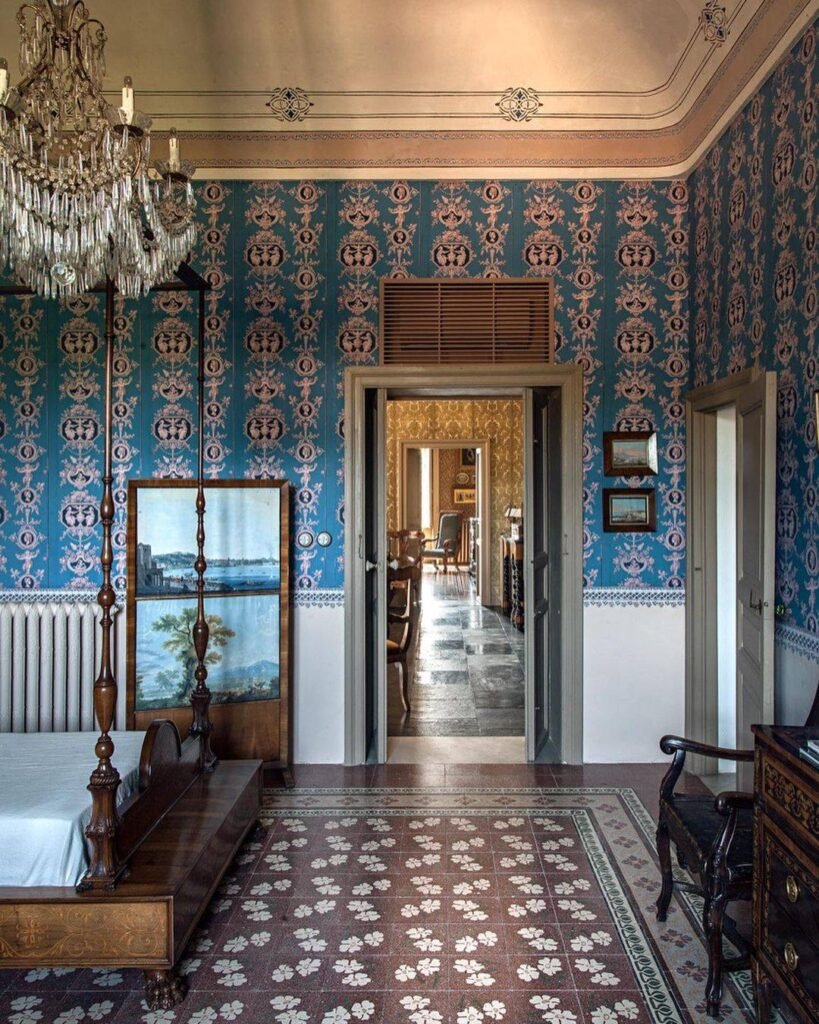The History
Villa Ruiz: A Sicilian House
The House of Marquises
The history of the Villa Ruiz in the 19th century is linked to that of a great noble family of the city of Noto, the Di Lorenzo family, marquesses of Casteluccio. The grand neoclassical palace in the center of the city was their primary residence, while the San Corrado villa was their summer home, with plenty of greenery and shade to escape the sweltering heat.
The grand neoclassical palace in the center of the city was their primary residence, while the San Corrado villa was their summer home, with plenty of greenery and shade to escape the sweltering heat.
The house became the Villa Ruiz when the marquess gifted it to the Ruiz family, a close ally that oversaw the estate. As is the case with many feudal estates, the former holdings of the Villa Ruiz are long dispersed and threatened by real estate speculation.
The house itself, perched on a rock of the hyblaean range, became long forgotten. It had been uninhabited for four decades when a foreign television producer, specializing in documentaries and in love with Sicily, bought it from the last heir of the Ruiz family.
Shortly thereafter, this same buyer purchased the Palazzo di Lorenzo del Casteluccio, reestablishing the link which had previously united the two buildings. The palace has since been sold, whilst the villa, still a private home whose location and vegetation has preserved its discretion, has been opened to the public this year.
Restauration: an act of love
The renovation of the Villa Ruiz was essentially philological, a true act of love and of respect for this region of Sicily, and was carried out by an expert architect of Noto, Corrado Papa, and a group of local workers. The geometry of the building is simple and classical, as are many villas in the Sicilian countryside.
The 19th century structure, with its vast central loggia, has prseerved its perfect symmetry: four rooms on the ground floor and four on the first floor.
The original floor plan has only been affected by construction work during the 20th century. Where the dining room stands today, the new owner had found a car garage built in the 50’s.
Perhaps an outside perspective was necessary to return the Villa Ruiz to its Sicilian charm and essence. The floor was restored with soft bitumen-covered limestone, a material called “pitch” by the people of Ragusa, whose traditional use in the area goes back to before the Hellenic period, while the ceramics come from Caltagirone and Santo Stefano di Camastra.
Echo Chamber...
The old kitchen has become a vast bathroom, leaving intact the cistern that was used to collect water. However, the objective wasn’t to transform the villa into a static icon, a stubborn mark of a bygone era, but rather to bring back the restless, discreet and hedonistic vitality of pre-Risorgimento Sicily. The interior of the Villa Ruiz is a veritable cultural echo chamber, as made evident by the leopard, an elegiac symbol of the feudal Sicilian nobility.
The echoes of the house resound further than Giuseppe Tomasi di Lampedusa and Luchino Visconti. They reveal a profound understanding of Sicily as it was and as it is today: the cradle and repository of a cultural heritage that belongs to all of Europe.
The artworks and furniture of the Villa Ruiz were chosen to inspire a voyage through time and space. On the walls, there are fifteen paintings of volcanoes: those of the Aeolian islands, the Etna, and the Vesuvius. This collection, beyond serving as a tribute to the geology of the islands of Southern Italy, serves as a reflection of the fashionable Grand Tour that so many wealthy European aristocrats engaged in during the 18th century, in which Sicily was the ultimate and most idealised destination.
Many paintings in the Villa Ruiz were created by artists, Englishmen and Frenchmen travelling through southern Italy and fascinated by volcanoes and the occasional eruption, before being acquired by the current owner through various brokers and auction houses across the Continent in order to return them to Sicily.
Harmony and eclecticism
The furniture comes from all across Europe. There are several treasures of Sicilian baroque architecture, such as the two mirrored console tables which constitute part of the history of the house, as they were gifted by the last Ruiz heir as a symbolic good omen. The other furnishings were purchased from various antiquarians of Catania and Palermo, prior to antiques becoming a widespread fashion, resulting in a chaotic market. The setting promotes dialogue and exchanges: Sicilian furniture shares the space with tables, chairs, desks and cabinets of various eras that once belonged to French, British, Portuguese, Russian and Dutch dynasties.
Despite this eclecticism, there is a philological reasoning: the Sicilian aesthetic is anything but homogenous. On this island, Greeks, Arabs, Normans, Frenchmen, and Bourbons passed through and prospered. The harmony of an authentic Sicilian villa would have depended on a variety of styles and not on a homogenous ensemble. Several details, such as the swimming pool built in on a terrace of the former courtyard and the opulent chapel with its reliquary, are not original features but would have undoubtedly been appreciated by the Casteluccios and the Ruiz. The remainder of the aesthetic work rests on the natural surroundings of the villa: the great fig trees at the entrance of the grounds, the olive grove, the bougainvilleas, palm trees, carobs, rosemary, jasmine, and the garden dotted with cacti from all around the Mediterranean basin.
A Sicilian "Nonna"
Restoring the Villa Ruiz to its former essence was not only a work of research, but also of imagination. “I always conceived the spirit of the house as the ghost of a Sicilian nonna,” confessed the new owner. “My wish was to make her happy”.
Restauration : A love story
The renovation of the Villa Ruiz was essentially philological, a true act of love and of respect for this region of Sicily, and was carried out by an expert architect of Noto, Corrado Papa, and a group of local workers. The geometry of the building is simple and classical, as are many villas in the Sicilian countryside.
The 19th century structure, with its vast central loggia, has prseerved its perfect symmetry: four rooms on the ground floor and four on the first floor.
The original floor plan has only been affected by construction work during the 20th century. Where the dining room stands today, the new owner had found a car garage built in the 50’s.
Perhaps an outside perspective was necessary to return the Villa Ruiz to its Sicilian charm and essence. The floor was restored with soft bitumen-covered limestone, a material called “pitch” by the people of Ragusa, whose traditional use in the area goes back to before the Hellenic period, while the ceramics come from Caltagirone and Santo Stefano di Camastra.

An echo chamber...
The old kitchen has become a vast bathroom, leaving intact the cistern that was used to collect water. However, the objective wasn’t to transform the villa into a static icon, a stubborn mark of a bygone era, but rather to bring back the restless, discreet and hedonistic vitality of pre-Risorgimento Sicily. The interior of the Villa Ruiz is a veritable cultural echo chamber, as made evident by the leopard, an elegiac symbol of the feudal Sicilian nobility. The echoes of the house resound further than Giuseppe Tomasi di Lampedusa and Luchino Visconti. They reveal a profound understanding of Sicily as it was and as it is today: the cradle and repository of a cultural heritage that belongs to all of Europe. The artworks and furniture of the Villa Ruiz were chosen to inspire a voyage through time and space. On the walls, there are fifteen paintings of volcanoes: those of the Aeolian islands, the Etna, and the Vesuvius. This collection, beyond serving as a tribute to the geology of the islands of Southern Italy, serves as a reflection of the fashionable Grand Tour that so many wealthy European aristocrats engaged in during the 18th century, in which Sicily was the ultimate and most idealised destination. Many paintings in the Villa Ruiz were created by artists, Englishmen and Frenchmen travelling through southern Italy and fascinated by volcanoes and the occasional eruption, before being acquired by the current owner through various brokers and auction houses across the Continent in order to return them to Sicily.

Harmony and eclecticism
The furniture comes from all across Europe. There are several treasures of Sicilian baroque architecture, such as the two mirrored console tables which constitute part of the history of the house, as they were gifted by the last Ruiz heir as a symbolic good omen. The other furnishings were purchased from various antiquarians of Catania and Palermo, prior to antiques becoming a widespread fashion, resulting in a chaotic market. The setting promotes dialogue and exchanges: Sicilian furniture shares the space with tables, chairs, desks and cabinets of various eras that once belonged to French, British, Portuguese, Russian and Dutch dynasties.
Despite this eclecticism, there is a philological reasoning: the Sicilian aesthetic is anything but homogenous. On this island, Greeks, Arabs, Normans, Frenchmen, and Bourbons passed through and prospered. The harmony of an authentic Sicilian villa would have depended on a variety of styles and not on a homogenous ensemble. Several details, such as the swimming pool built in on a terrace of the former courtyard and the opulent chapel with its reliquary, are not original features but would have undoubtedly been appreciated by the Casteluccios and the Ruiz. The remainder of the aesthetic work rests on the natural surroundings of the villa: the great fig trees at the entrance of the grounds, the olive grove, the bougainvilleas, palm trees, carobs, rosemary, jasmine, and the garden dotted with cacti from all around the Mediterranean basin.

A Sicilian "Nonna"...
Restoring the Villa Ruiz to its former essence was not only a work of research, but also of imagination. “I always conceived the spirit of the house as the ghost of a Sicilian nonna,” confessed the new owner. “My wish was to make her happy.”
Fondazione del Grand Tour
Utilities
Menu
Via Villino Villadorata, 8 96017 Noto (SR) Sicilia
Link utili
Menu
Fondazione del Grand Tour
Via Villino Villadorata, 8 96017 Noto (SR) Sicilia
